Author : John Parker
How to apply SketchUp in education
Designed to allow “… everybody to experience the power and fun of building their ideas in CAD” (Schell, n.d.), Google SketchUp is a 3D modelling program that allows the users to model almost any object that they wish. The depth of the program provides users with the ability to create realistic virtual models and a range of 'plugins' extend this to 'augmented reality' models, 3D printing and pattern development and cardboard modelling.
Meg Ormiston (2011) describes Google SketchUp as "... amazingly powerful 3D modelling software..." (Ormiston, 2011, p. 35). She talks about the ability to increase student engagement by building a digital-rich curriculum. She says that Google SketchUp and Google Earth are integral for engagement, collaboration and active learning. SketchUp integrates with Google Earth in a seamless manner to provide the user the opportunity to place the models in a real world context. This can be achieved by either importing the appropriate location from Google Earth into the SketchUp workspace, or by exporting a completed model into Google Earth itself. |
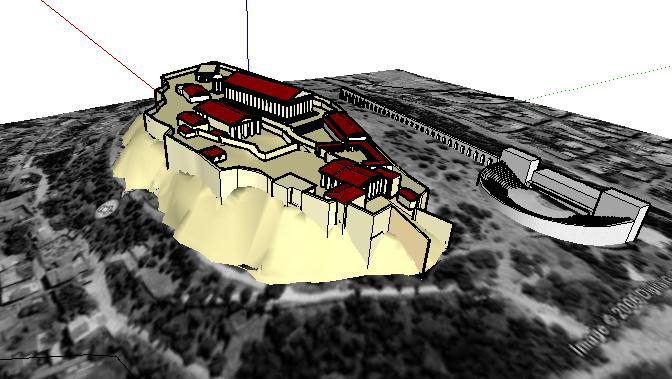 |
|
|
Figure 2: Model of the Acropolis, showing the relationship between Google SketchUp and Google Earth |
The relationship between Google Earth and Google SketchUp creates excellent learning opportunities in the Social Sciences, particularly History and Geography. The use of models that have been uploaded to Google Earth allows students to experience a much more realistic view of areas being studied. Many of the 'great' centres of the world have been fully modelled (from Google SketchUp and 'Building Maker') and virtual tours of these places can be held at the click of a (mouse) button.
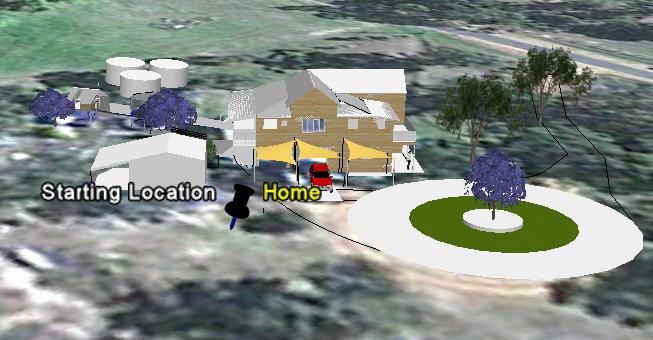 |
Other instances where Google SketchUp can be used to harness the power of Google Earth is in the ability to create '*.kmz' files of locations with SketchUp models embedded. These can then be distributed via email to a range of other users, allowing collaboration and a shared understanding of the work being covered. The ability for students to interact in a virtual environment, both individually and collaboratively further supports Brutzman's (1999) views on the benefits of 3D modelling as a medium for communication in the wider community. |
Figure 3: Model of the author’s house uploaded to Google Earth |
|
3D Warehouse: The 3D modelling process allow users to generate models that can be integrated into a range of learning experiences or to access objects from the '3D warehouse' (a repository of models created and uploaded by their makers for use by the SketchUp community) (visit http://sketchup.google.com/3dwarehouse ). |
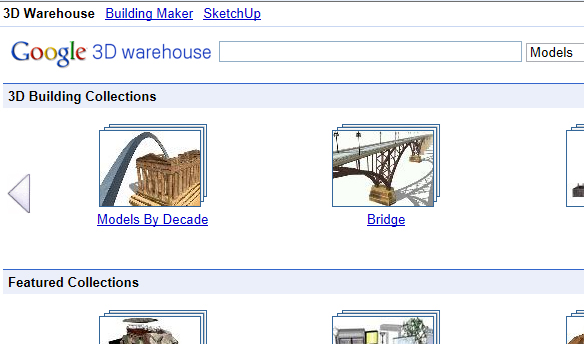 |
|
|
Figure 4: Sample of the Google Warehouse homepage |
These objects can be used to engage students by setting the scene for an oral presentation, as seen in the image of the student delivering a piece from Shakespeare, appearing to be on the stage of the Globe Theatre. It can also be used to position an audience in an Ancient History class with models of Ancient Greece or Rome. There are even realist 3D models of people from these times that can help engage the students, especially when presented in a life size view in the classroom (see AR image of Legionnaire).
TPACK: The use of Google SketchUp to enhance the learning experiences of students fits well with the TPACK model (Koehler, 2011). In most cases, using SketchUp would be classed as a 'TCK' experience, where the knowledge covered during the activity would be technological knowledge and content knowledge (TCK). If used in a more deliberate manner, with a focus on the engagement and learning, the activity becomes technological, pedagogical and content (TPCK).
The design of the Information booth at the Parthenon is an example of TCK, whilst the use of the Globe theatre as a backdrop, or the augmented reality modelling of the furniture reflects a TPCK activity, considering the level of engagement that the students exhibited (Warschauer, 2007). It is in the ability to provide learning experiences that cover the three areas of the TPACK model, regardless of the subject area, that the power of Google SketchUp as a cross-curricular application really comes to the fore. |
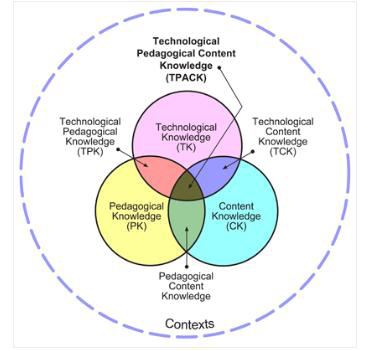 |
Figure 5: TPACK Model |
In Brutzman's study, he concluded that "… Developing cross-disciplinary virtual worlds with an emphasis on reality provides students with excellent insight, enthusiastic motivation and useful learning exemplars." (Brutzman, 1999, p. 11)
Whilst the use of Google SketchUp does not go as far as creating a virtual world, it does allow the creator and the user to engage more fully with the object in its environment. Breuleux (2001) further supports this in the discussion on the use of ICT in schools when describing how ICT can support more complete experiences (of collaborative knowledge building) by integrating "… well-designed technologies in the context of meaningful, mindful inquiry projects, non-presentational pedagogies, access to resources and tools, and adequate support for technological maintenance and pedagogical renewal." (Breuleux, 2001, p. 3) As this document shows, Google SketchUp provides teachers the opportunity to enable this to happen for their students.
Plugins: The range of 'plugins' available for Google SketchUp is extensive and further enhances the programs value as an environment for all aspects of learning. The list of plugins is extensive, and few people would need or even wish to access all of those that are available. There are a number of plugins that teachers can use to enhance the learning experience and a number of these will be discussed here. As teachers (and students) made use of Google SketchUp, they would continue to find more applications for the program and the plugins available.
SketchyPhysics is one plug in that enhances SketchUp's usefulness in a range of areas, notably in the sciences (http://code.google.com/p/sketchyphysics). This plugin allows the user to ably characteristics to the elements created, which allows them to interact with each other in the work space. This is important in the animation of the models produced. The models need to reflect natural elements as closely as possible in order to deliver the most real experience. |
 |
Figure 6: Screenshot of the Sketchyphysics website |
|
Another plugin that continues to inspire users is the AR- Media plugin from Inglobe Technologies |
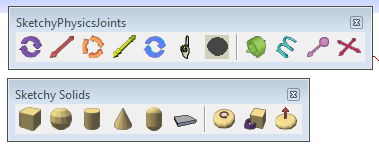 |
Figure 7: Sketchyphysics Toolbars |
www.inglobetechnologies.com, 2011. Augmented reality is an area of growth in the education and this plugin allows students and teachers to integrate this technology into the learning experiences. The diagrams included show a number of different applications for the AR-Media plugin, modelling of a robot, furniture and a house in a graphics course, the Osaka Castle modelling demonstration in a Japanese unit and projections of a Roman soldier as part of history. The ability of users to take models created in Google SketchUp and interact with lifelike (and life size) augmented reality models further enhances the level of engagement and the value of the learning activity.

Figure 9: Selection of Images using Google SketchUp and AR Media
Waybe is another plugin that enhances the value of Google SketchUp. The Waybe plugin (and other similar ones like it) provides the user with the ability to create 'developments' or 'nets' of the objects created. Understanding the volume of the objects created is an important tool for many mathematical concepts. It is also inspiring for students to be able to produce a cardboard model of their object that they can share with others.

Figure 10: Selection of images using Waybe. a) Waybe Toolbars, b) SketchUp Image and c) Waybe pattern development
Lipson (1999) discusses the motivation for the use of physical models in education and their importance for active learning. Spatial concepts can be difficult for some students to grasp and these can be addressed through the use of Google SketchUp. Another set of plugins that further enhances these concepts are 3D printing plugins that allow the production of physical models, based on Google SketchUp files. Although requiring additional 3D printing capabilities, this is another area that further demonstrates the cross-curricular application of SketchUp. |
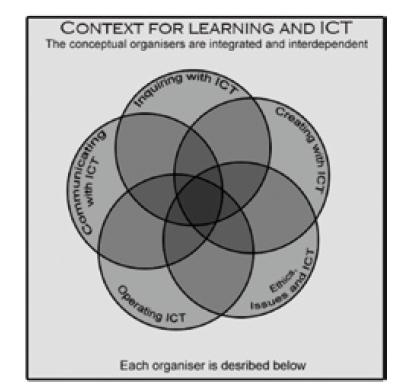 |
Figure 81: The relationship between the conceptual organisers of ICT |
A review of the NET-S standards shows the value of using Google SketchUp across the curriculum. Successful integration of Google SketchUp in the learning experiences addresses elements of all 6 of the standards for students (ISTE, 2007) as well many of the standards for teachers (ISTE, 2008)
Using Google SketchUp also fits well with the organisers from the Statement of Learning for Information Communication Technologies (Curriculum Corporation, 2006) and the elements of the Essential Learnings Information Communication Technologies (ICTs) Cross Curricular Priority (Quuensland Studies Authority, 2007)
The SketchUp4Architects site (http://www.sketchup4architect.com/benefits-of-communication-and-Visualization-sectors-by-sketchup.htm) describes the benefits of using Google SketchUp for communication and visualisation. As is stated in the conclusion, "… the detailed, colourful and realistic models give a more profound understanding of any design" (Narth, 2011). This is one of the key benefits of the use of Google SketchUp as a learning tool.
As this paper has shown, Google SketchUp offers opportunities to engage with students across a broad spectrum of subject areas and a range of age groupings. The program provides users opportunities to interact digitally in a range of environments at almost any level of technical ability. Google SketchUp should be a key part of a teacher's digital toolbox.
Bibliography
Breuleux, A. (2001). Imagining the present, interpreting the possible, cultivating the future:Technology and the renewal of teaching and learning. Education Canada, 41(3). Retrieved August 15, 2011
Brutzman, D. (1999, December 1). Teaching 3D Modeling and Simulation: Virtual Kelp Forest Case Study. Retrieved from citeseerx.ist.psu.edu/viewdoc/download?doi=10.1.1.107.2421.pdf
Curriculum Corporation. (2006). Statements of Learning for Information and Communication Technologies (ICT). Retrieved August 21, 2011, from http://www.iste.org/Libraries/PDFs/NETS_for_Student_2007_EN.sflb.ashx
ISTE. (2007). The ISTE NETS and Performance Indicators for Students (NETS•S). Retrieved August 21, 2011, from International Society for technololgy in Education: Standards: http://www.iste.org/Libraries/PDFs/NETS_for_Student_2007_EN.sflb.ashx
ISTE. (2008). The ISTE NETS and Performance Indicators for Teachers (NETS•T). Retrieved August 21, 2011, from International Society for Technology in Education: http://www.iste.org/Libraries/PDFs/NETS_for_Teachers_2008_EN.sflb.ashx
Koehler, M. J. (2011, May 13). What is TPACK? Retrieved from TPACK- Technollogy Pedagogical and Content Knowledge: http://mkoehler.educ.msu.edu/tpack/what-is-tpack/
Lipson, H. (1999). Printable 3D Models for Customized Hands-on Education. Ithaca NY: Sibley School of Mechanical and Aerospace Engineering, Cornell University.
Narth, D. (2011, March). SketchUp4Architects: Beneifts of Communication and Visulalisation Sectors by SketchUp. Retrieved August 14, 2011, from SketchUp4Architects: http://www.sketchup4architect.com/media/2011/march/sketchup-ur-space-march11.pdf
Ormiston, M. (2011). Creating a Digital Rich Classroom. Bloomington IN: Solution Tree Press.
Quuensland Studies Authority. (2007). Retrieved August 21, 2011, from http://www.qsa.qld.edu.au/downloads/early_middle/qcar_ccp_ict_yr9.pdf
Warschauer, M. (2007). The Paradoxical Future of Digital Learning. Learn Inq(1), pp. 41-49.
List of Figures
Figure 1: Google SketchUp Home page: http://sketchup.google.comm/
Figure 2: Model of the Acropolis, showing the relationship between Google SketchUp and Google Earth Retrieved 7 September 2011.from
http://sketchup.google.com/3dwarehouse/details?mid=6c7cbd5ba83e2edf5bc6c31ea6ff5c5d&prevstart=0
Figure 9: Model of the author’s house uploaded to Google Earth
Screen clipping taken: 7/09/2011
Figure 10: Sample of the Google Warehouse homepage
Figure 5: Augmented Reality Model of a Roman Legionaire created in Google SketchUp and visualised through AR Media
Figure 11: TPACK Model : http://mkoehler.educ.msu.edu/tpack/what-is-tpack/
Figure 12: Screenshot of the Sketchyphysics website
Figure 13: Sketchyphysics Toolbars
Figure 9: Selection of Images using Google SketchUp and AR Media
Figure 10: Selection of images using Waybe. a) Waybe Toolbars, b) SketchUp Image and c) Waybe pattern development.
Fgure 11: The relationship between the conceptual organisers of ICT (Curriculum Corporation, 2006)
- Cover Story
-
 SketchUp Can Help You Win Interior..
SketchUp Can Help You Win Interior.. -
 Best Laptops for SketchUp
Best Laptops for SketchUp -
 How to Resize Textures and Materials..
How to Resize Textures and Materials.. -
 Discovering SketchUp 2020
Discovering SketchUp 2020 -
 Line Rendering with SketchUp and VRay
Line Rendering with SketchUp and VRay -
 Pushing The Boundary with architectural
Pushing The Boundary with architectural -
 Trimble Visiting Professionals Program
Trimble Visiting Professionals Program -
 Diagonal Tile Planning in SketchUp
Diagonal Tile Planning in SketchUp -
 Highlights of some amazing 3D Printed
Highlights of some amazing 3D Printed -
 Review of a new SketchUp Guide
Review of a new SketchUp Guide
- Sketchup Resources
-
 SKP for iphone/ipad
SKP for iphone/ipad -
 SKP for terrain modeling
SKP for terrain modeling -
 Pool Water In Vray Sketchup
Pool Water In Vray Sketchup -
 Rendering Optimization In Vray Sketchup
Rendering Optimization In Vray Sketchup -
 Background Modification In sketchup
Background Modification In sketchup -
 Grass Making with sketchup fur plugin
Grass Making with sketchup fur plugin -
 Landscape designing in Sketchup
Landscape designing in Sketchup -
 Apply styles with sketchup
Apply styles with sketchup -
 Bedroom Making with sketchup
Bedroom Making with sketchup -
 Review of Rendering Software
Review of Rendering Software -
 Enhancing rendering for 3d modeling
Enhancing rendering for 3d modeling -
 The combination of sketchup
The combination of sketchup -
 Exterior Night Scene rendering with vray
Exterior Night Scene rendering with vray






